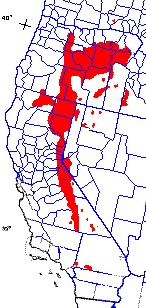
Range map (3).
Common Names
Western, Sierra or yellow juniper; yellow or western red cedar (2).Taxonomic notes
Two varieties, occidentalis (syn: Sabina occidentalis (Hooker) Antoine (4)) and australis .Description
"Trees monoecious or dioecious, to 20(-30) m, single-stemmed; crown rounded to conical. Bark red-brown to brown, exfoliating in thin strips, that of small branchlets (5-10 mm diam.) smooth, that of larger branchlets exfoliating in scales or flakes. Branches spreading to ascending; branchlets erect, 3-4-sided in cross section, ca. 2/3 or less as wide as length of scalelike leaves. Leaves green, abaxial glands ovate to elliptic, conspicuous, with yellow or white exudate, margins denticulate (at 20×); whip leaves 3-6 mm, not glaucous adaxially; scalelike leaves 1-3 mm, not overlapping, rounded, apex acute to obtuse, appressed. Seed cones maturing in 2 years, of 2 distinct sizes, with straight peduncle, ovoid, 5-10 mm, blue to blue-black, glaucous, fleshy and resinous, with 2(-3) seeds. Seeds 2-4 mm" (4).For var. occidentalis only: "Bark red-brown. Plants often (50%) monoecious. Seed cones (5)7.5(9) mm" (4).
Range
USA: Washington, Oregon, Idaho, Nevada and California (1). See also (6). Variety occidentalis is found at elevations of 0-3000 m, mostly on dry rocky slopes (4).Big Tree
See variety australis.Oldest
The very oldest specimens are of variety australis . The oldest sampled specimen of the type variety is 1600 years old, and is still alive (see Dendrochronology, below).Dendrochronology
Both varieties have been used in climate studies. Var. occidentalis has proved particularly useful in dendroclimatology; many collections are tabulated in (5). Rick Miller, researcher out of Oregon State University, reports (pers. comm. 30-Jul-1999) "The oldest western juniper (var. occidentalis) we have aged to date is 1600 yrs (solid to pith). We have aged around a dozen that are between 1,000 and 1,500 years. These are living trees and have been working with the tree ring lab at Univ. of Ariz. to develop a master chronology. There are probably older trees but it is very difficult to find old trees solid enough to age to the pith. Working with Chris Basian and Dave Meko from the lab we have cross dated standing dead trees with pith dates going back to around 100 BC. These trees have been dead for 500 to 600 years.Ethnobotany
Observations
Var. occidentalis can be seen widely in the West, notably at the Juniper Dunes Wilderness in WA (its N range limit) and throughout much of E Oregon, SW Idaho and NW Nevada.Remarks
Citations
(1) Silba 1986.(2) Peattie 1950.
(3) Burns & Honkala 1990.
(4) Adams, Robert P. in Flora of North America online.
(5) Holmes et al. 1986.
(6) Robert S. Thompson, Katherine H. Anderson and Patrick J. Bartlein. 1999. Atlas of Relations Between Climatic Parameters and Distributions of Important Trees and Shrubs in North America. U.S. Geological Survey Professional Paper 1650 A&B. URL= http://greenwood.cr.usgs.gov/pub/ppapers/p1650-a/pages/conifers.html, accessed 22-Jan-2000.
See also
Elias 1987.
Lanner 1983
.
Little 1980.
back | Juniperus | Cupressaceae | home
This page is from the Gymnosperm Database
URL: http://www.geocities.com/~earlecj/cu/ju/occidentalis.htm
Edited by Christopher J. Earle
E-mail:
earlecj@earthlink.com
Last modified on 22-Jan-2000